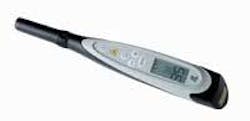A new diagnostic paradigm
The classic way to examine patients for caries is the explorer. Typically the explorer, combined with visual inspection using magnification and film or digital radiographs, has been our approach to this critical diagnostic component of dental care.
Over the past few years, a new technology emerged that made an important new tool available to dentists. The KaVo DIAGNOdent® laser caries detection system has proven so effective in identifying caries at an early stage that it has, in my opinion, caused a paradigm shift in dental diagnosis.
I don’t use that term lightly. The early detection afforded by the DIAGNOdent means that we can provide much less invasive therapies. Since we can now catch caries when it is significantly smaller, we can better preserve tooth structure during treatment. Restorations that follow from diagnosis with DIAGNOdent are simply much smaller than those that are placed as a result of diagnosis with traditional tools.
The DIAGNOdent itself is very compact, consisting of a small, battery-powered base connected to a probe that is similar to a thin handpiece. The unit is also available in a self-contained “pen” style. Both systems have a digital display with a numeric reading. On the standard unit, the display is on the base. On the pen, the display is actually on the handle.
This is how it works: DIAGNOdent uses laser technology to identify carious lesions at the earliest possible stage by detecting laser fluorescence within the tooth structure. Clean, healthy teeth exhibit little or no fluorescence. When the laser encounters a carious area, it detects fluorescence. The more significant the caries is, the higher the reading on the display.
I use DIAGNOdent in conjunction with all the other diagnostic tools, including the explorer, magnification, and digital radiography. It’s not meant to replace existing technologies, but it is a tool that, used in conjunction with other tools, makes our ability to diagnose caries much more effective than with traditional tools.
Our practice is a large and busy one, with two dentists and several hygienists working full-time. We typically see as many as 30 patients a day, and up to 150 patients a week. Whenever patients come in for cleanings, X-rays, or regular check-ups, my partner and I routinely use DIAGNOdent during our examination. The unit, which is small and portable, is kept in the hall outside the operatories.
We’ve increased the number of early detections by more than 30 percent since we installed the technology, and we’re placing more restorations as a result. This has obviously translated into an increase in my bottom line.
While increased revenue is important, my focus is always on patient care. With DIAGNOdent, we’re sending a strong message to patients that their welfare is our main concern and that we’re using the most effective technology to ensure that we provide them with the finest care. It’s this bottom line of improved patient care that’s the real paradigm shift in diagnosis.Jeffrey B. Dalin, DDS, FACD, FAGD, FICD, practices general dentistry in St. Louis. He also is the editor of St. Louis Dentistry magazine, and spokesman and critical-issue-response-team chairman for the Greater St. Louis Dental Society. He is one of the co-founders of the Give Kids A Smile Program. Contact him by e-mail at [email protected], by phone at (314) 567-5612, or by fax at (314) 567-9047.

